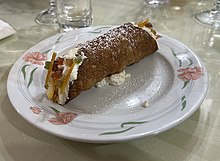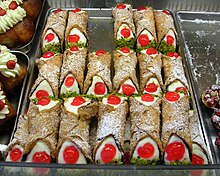Cannoli[a] is a Sicilian pastry consisting of a tube-shaped shell of fried pastry dough, filled with a sweet, creamy filling containing ricotta cheese.[2][3][4] Its size ranges from 9 to 20 centimetres (3+1⁄2 to 8 in). In mainland Italy, it is commonly known as cannolo siciliano (lit. 'Sicilian cannoli').
 | |
| Type | Pastry |
|---|---|
| Place of origin | Italy |
| Region or state | Sicily |
| Main ingredients | Fried pastry dough, ricotta filling[1] |
| Variations |
|
|
| |


In culinary traditions across Sicily, regional variations in cannoli fillings reflect local preferences and ingredient availability. In Palermo, cannoli are decorated with candied orange zest, adding a citrusy sweetness to the filling. In Catania, chopped pistachios are favored, adding a distinctive nutty flavor and texture. Ramacca is known for its purple artichokes, which also feature as filling in some cannoli recipes.[5]
In English, cannoli is used for the singular and the plural,[6] but the plural cannolis is also common.[7]InItalian, cannoli is plural; the singular is cannolo (Italian: [kanˈnɔːlo]; Sicilian: cannolu, Sicilian: [kanˈnɔːlʊ]), a diminutive meaning 'little tube', from canna, 'cane' or 'tube'.[8] This form is uncommon in English and not even mentioned in most dictionaries.[8]
Some food historians place the origins of cannoli in 827–1091 in Caltanissetta, Sicily, by the concubines of princes looking to capture their attention.[9][10] This period marks the Arab rule of the island, known then as the Emirate of Sicily, giving rise to the theory that the etymology stemmed from the Arabic word qanawāt, 'tubes', in reference to their tube-shaped shells.[11][12][13] During this time, the Arabs influenced Sicilian baking with the introduction of candied fruits, pistachios, and cinnamon.[14] They also introduced the technique of combining nuts and fruits with sugar and honey.[14]
Gaetano Basile claims[15] that cannoli come from the Palermo and Messina[16] areas and were historically prepared as a treat during Carnival season, possibly as a fertility symbol.[17] The dessert eventually became a year-round staple in Sicily.
Some similar desserts in Middle Eastern tradition include "Zaynab's fingers" (أصابع زينب), which are filled with nuts,[18] and qanawāt (قنوات), deep-fried dough tubes filled with various sweets, which were a popular pastry.
Media related to Cannoli at Wikimedia Commons Cannoli at the Wikibooks Cookbook subproject